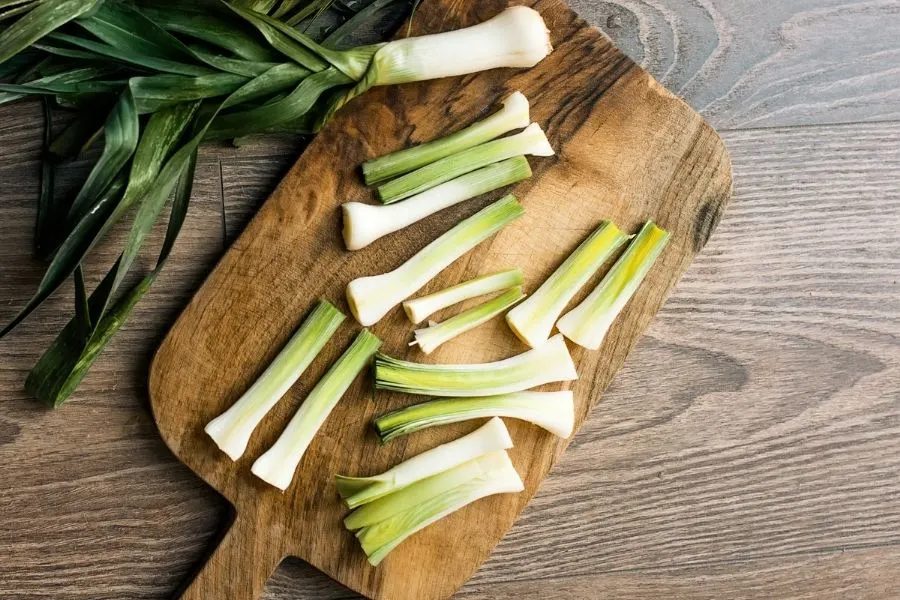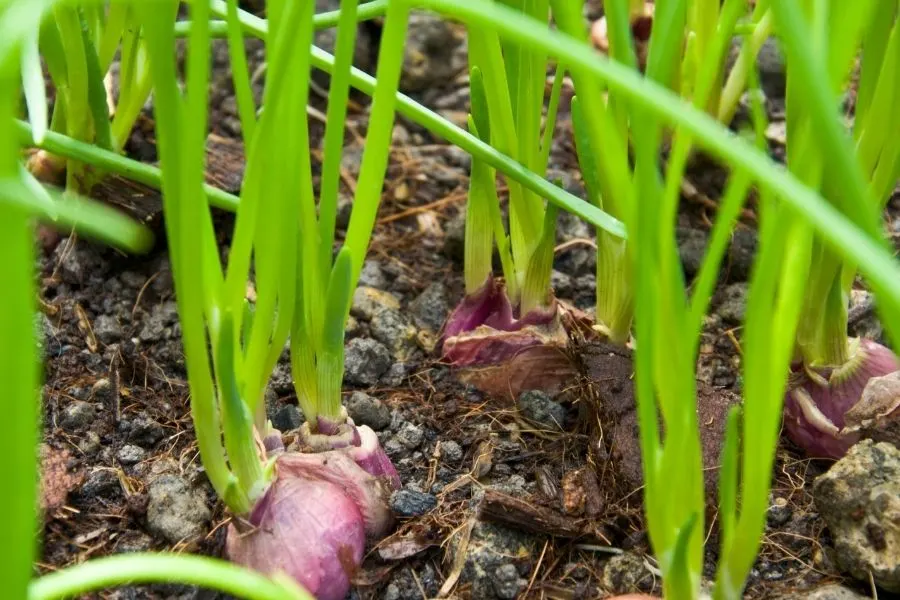Looking to make that amazing summer salad but you’re fresh out of green onions ? It happens to the best of us, but don’t worry. There are a few substitutes you can use in place of green onions. Some of them might even be in your fridge or pantry right now !
To be fair, few items will reach that perfect balance of fresh and pungent like green onions do. Cut there may just be something you can use from this list. And towards the end we’ll tell you how to grow your own green onions, so you never run out !

Best green onion substitute
The best green onion substitutes are chives, shallots, ramps and leeks. If you don’t mind changing the flavor a little, you can try green garlic ! Leeks, chives, and green garlic are all similar in appearance to green onions, so they won’t change your meal’s appearance.
For those who aren’t sure what green onions are, they’re just the very young versions of regular onions. Basically immature onions that have been harvested in spring, when the green sprouts have reached over a foot in length.
The have a delicate, pungent flavor. Especially when you compare then with regular, fully-grown onions. Now let’s take a look at those substitutes, shall we ?
Leeks
Probably your first choice, for several reasons. Leeks look like overgrown, sturdy green onions. Way bigger, with very wide and long leaves. Leeks are much more pungent than green onions, and they’re thicker too.
As in the green parts are much more fibrous, and require cooking. By comparison the greens in green onions should remain raw.
If you opt for leeks, make sure to slice them very thinly. And don’t underestimate what a single leek can do. A whole leek head (just the white part) is as much as a medium white onion.

Chives
Chives are are a much milder version of green onions, so you may have to use more. Depending on what you’re making chives could be a great or terrible substitute. Chives should not be cooked, as they will wilt and lose their fresh flavor.
But if you’re adding chopped chives as a topping, garnish, or are using them in something cold like a salad, they work great. Use chives as you would use the greens in a green onion.
Green garlic
Green garlic isn’t another name for chives, although chives are sometimes called green garlic. In truth. green garlic is regular garlic that is very young. Just like green onions.
You’ll notice that green garlic has a single, small bulb, unlike adult garlic. This is because garlic starts to divide itself into several cloves when it’s mature. That division into several pieces is its way of reproducing.
Back to green garlic. It’s a very fresh flavor, less pungent than adult garlic. Its leaves are just as long and delicate as green onions, but the white head is more sensitive. It doesn’t take as well to frying, and should only be sauteed lightly.
Shallots
Ah well, what if there’s nothing else in your pantry but shallots ? Those will do just fine. After all, shallots have a much milder flavor than regular onions are are often touted as the delicate cross between garlic and onion.
So grab yourself a shallot and use it just like a green onion. The flavor will be a little different, yes, but it will substitute the white part of green onions. If you want you can use shallots in their raw form, instead of the greens in green onions.
We’re pretty sure that if you look hard enough in supermarkets you’ll find green shallots, or spring shallots. Just like green onions, but this time they’re shallot bulbs.

Ramps or wild leeks
A less common option is to use wild leeks, otherwise known as ramps. No, not the ramps you get cars on to work under them. Just the word ramps. They’re also known as wood leeks, as they usually grow in maple or mixed-wood forests.
Hard to find in stores, unless you go and pick some in the forest yourself. They’re a very nice cross between onion and garlic in terms of flavor.
Can I use regular onion for green onion ?
Regular onions are much more pungent and may change the flavor of the dish completely. If using raw, like for a salad or cold platter than yes you could, just in a small amount.
Add some lettuce to give the onion a fresher, more vibrant flavor. It also works great if you’re trying to ‘fake’ a green onion being chopped up in a salad, or a cold mix
Are green onions and scallions the same thing ?
Yes, green onions and scallions are the exact same thing. So are spring onions ! This means that whatever you see them labeled as in supermarkets or farmer’s markets, they’re one and the same.
Some people call them spring onions, because that’s when they come into season. Young onions start to sprout, and those sprouts are then plucked.
As for scallions, that’s just the name given to any garlic or onions that has a small bulb and long, green leaves. Most people know of scallions as being green onions though.
Read Also:Why Do Onions Have Layers ?
Grow your own (green) onions
Wouldn’t you like to have your very own onion stash ? Okay, maybe just a small stock of green onions ? Sounds better ? Depending on how much your family loves onions in general, and green onions in particular, you can try planting your own !
No grocery trips for a few green onions, nope, you’ve got yours right at home. So how do you grow green onions ? It’s not like onions have clear, immediately-obvious seeds like apples or sunflower seeds.
When you get the ‘root’ of an onion, keep it. The bottom part, with all those white, short mustaches. Yes, that ! Whether you have it from regular onions or from green onions, it will work the same.
Green onions are just the baby versions of regular onions. Keeping their roots will allow you to plant them back into the soil, to grow a new onion crop.
You can let the crop grow fully into onions, or pick then when they’re young and green. Or pick some and let some grow into adult onions. This way you’ll have both onions and green onions !
Okay so how do you do this ? This guide explains everything. You need at leas one onion root, a very small glass jar or cup, and a bright, sunny place. Put the roots in the cup, root-side down. Add enough water to cover the roots but don’t submerge the whole thing.
Give it a few days in a sunny spot. You can even do this outside if you want. After a few days you should notice bright green shoots; let them grow to almost half a foot. Plant in good quality soil, indoors or outdoors. Keep in mind that they might flower, and smell a little oniony so we recommend keeping them outside.
Now you can grow your very own green onions ! If you want to only use the green parts, cut off as much as you need and it will keep growing. The bulb will turn into a big, regular onion if you never dig it up.
If you want the white part, take out the whole onion a few days after planting, when the leaves a longer.
Keep in mind that onions can only regrow so much. After a while you will need to replenish the soil, whether by adding a peanut crop as a refresher or simply getting new soil.

